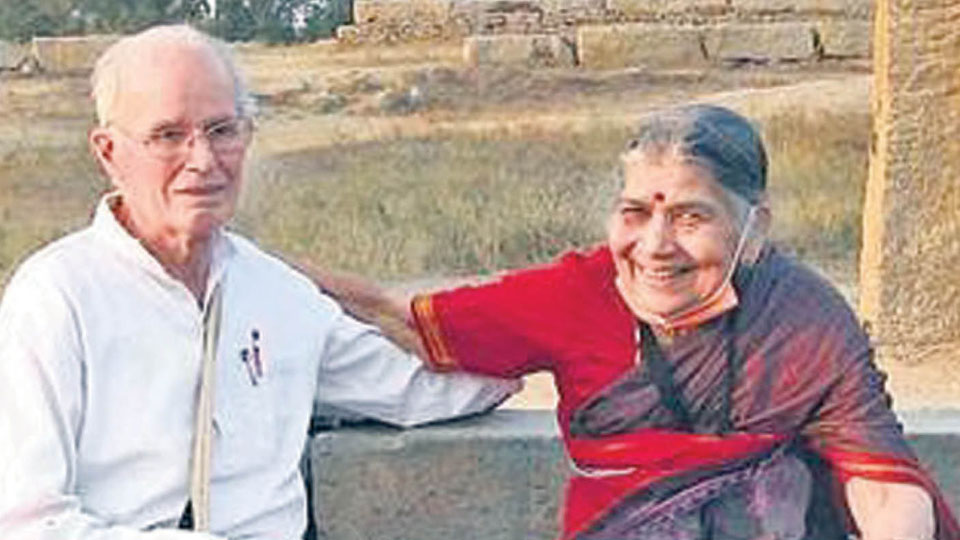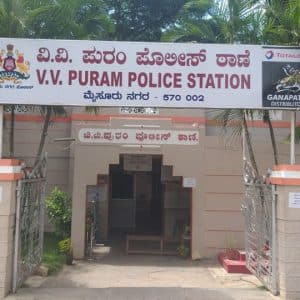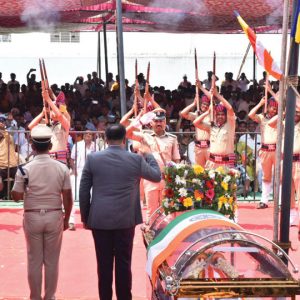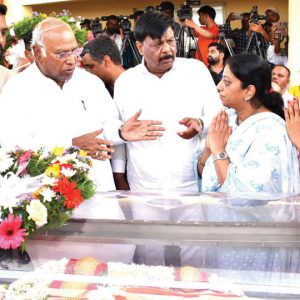Dr. Pierre Sylvain Filliozat and Dr. Vasundhara Kavali Filliozat
Shree Vanamali Samskruti Seva Award, instituted by Shree Vanamali Charitable Trust, Mysuru, would be awarded to the well-known Sanskrit Scholar Dr. Pierre Sylvain Filliozat and his wife Dr. Vasundhara Kavali Filliozat, a noted Art Historian and Epigraphist, tomorrow at 10.30 am at Veene Seshanna Bhavan of Ganabharathi, Adichunchanagiri Road, Kuvempunagar in city.
On this occasion, here we reproduce excerpts from an article by Dr. Vasundhara Kavali Filliozat we had published in Star of Mysore dated July 28, 2021, under the title “Study of Epigraphy: An appeal to Government of India.” — Ed
I was shocked to read the news item titled “Epigraphists Join Nationwide Stir” in Star of Mysore dated 15th July 2021. Epigraphists were manifesting their colère because Government of India was diverting the subject of Epigraphy to other fields like Horticulture etc.
It is well-known all over the world that India is one of the richest countries in the field of Epigraphy. That which is written on stones, imperishable materials like metal plates is called Epigraphy. By and large, inscriptions are in temples. Each temple had its own reader, he or she would explain the facts recorded in charters. In this way, historical facts were publicised, popularised. Besides, every temple had its own archive. Victim of the time, the temple archives have been lost. To the good luck of the researchers and historians, somehow or the other a good number of inscriptions have survived in temples.
The art of writing on stones and other materials started in India, as per the present day research, from the times of King Ashoka of Maurya dynasty, 3rd century BCE. (The antiquity of Indian writing will go back to still earlier date, the day Harappa and Mohenjodaro seals are deciphered.) Ashokan inscriptions are in Brahmi script and the language is Prakrit. This script is at the origin of not only all Indian writings but also in those of South East countries like Nepal, Sri Lanka, Thailand, Cambodia etc.
Originating from Brahmi letters, each region developed its own alphabets yet following the rules of grammar prescribed by Panini. The speciality of our Indian writing is that each vowel has a particular sign and when added to the consonant it gives the desired nāda, “sound”. In English when “ut” is added to P or B the pronunciation is not the same. In the Indian writing this problem does not arise. That makes the reading easy and sweetened sounds.
Palaeographers have prepared charts to show the development letters century by century and pointed out how the Brahmi script of Ashokan times underwent changes. It is universally accepted that the “Inscriptions are the official and contemporaneous documents issued by kings, officers and other philanthropists. These inscriptions provide first-hand information for rewriting the history of its country. These records can be classified in different categories such as benevolent grants, memorial stones etc.
Memorial stones
By and large, the date, name of the ruler, the occasion for making the grant, details of donation are the main matters of each Epigraph. Memorial stones can be divided in two groups, namely Hero stones and Sati stones. Hero stones, while recording the death of a hero, mention the date and the occasion of the event too. Many a times while recording the purport of the conflict, name of the ruling king, date and the purport of the conflict etc., are mentioned. Heroes who died in combat are taken to heaven by celestial nymphs and pass through the disc of the sun. So they have no rebirth. Often the wives of heroes have courageously sacrificed their lives by jumping in the funeral pyre of their defunct husband. These ladies are worshipped as Goddesses.
Sacrificed Sati images are also carved on stones. They are portrayed with raising the right hand holding sometimes a lemon or a mirror signifying that she was not a widow. All these facts are beautifully depicted in image and many a times accompanied by a brief text on stone.
The study of Epigraphs helps to determine the date of kings, extension of their territories, political, social, religious and economic conditions of the selected period. Inscriptions are like oceans. At every reading, new facts come to light like a hidden treasure in the ocean. There were poets/learned savants to draft the text, scribes to write it on stones and sculptors to incise the letters. Once the text is ready on the stone, there were readers to read/sing and explain them to the public. Thus the benevolent act of the mécène was publicised and popularised.
Decipherer of Ashokan inscriptions
In the beginning, a few European scholars in India were interested in the study of Epigraphs. Although James Prinsep is honoured as the decipherer of Ashokan inscriptions, he was helped by many Indian scholars like R.G. Bhandarkar, Bhau Daji etc., as well as Eugène Burnouf, a French Indologist in Paris. As the interest in Epigraphy grew gradually, soon scholars like Kielhorn, Hultsch, L. Rice, J.F. Fleet and Indian scholars namely R.G. Bhandarkar, Bhau Daji, Gopinath Rao, B. Ch. Chhabra and many others embarked on to decipher inscriptions of different periods of different regions and published them with word by word translations, notes and comments in the early volumes of Asiatic Researches, Indian Antiquary and other journals and so on. In the field of Epigraphy, especially with regard to the inscriptions of Karnataka, Fleet’s works hold a prominent place. He had published many Kannada and Sanskrit inscriptions.
Epigraphic service began to function regularly as part of Archaeological Survey of India (ASI) with its establishment in 1880 in Delhi. Soon branches of Epigraphy were opened in major States…
No Indian Epigraphists in France Academy
In Paris, France, there are five Academies and one of them is Académie des Inscriptions et des Belles Lettres. Most members of this Academy are Chartists. Now also there are members who are specialised in Armenian, Cuneiform tablettes of Iraq and Syria, Chinese. But there is no Epigraphist for Indian inscriptions. Prof. Pierre Sylvain Filliozat is the member of the Academie. But he is a Sanskritist. Yet time-to-time he speaks about Indian Epigraphy.
Why there are no Indian Epigraphists in the Academy in France? The reason is very simple. Study of Epigraphy had not received much attention in the Government of India and the Indian public. Only in the Universities, Epigraphy is taught. Some recognised institutions like Mythic Society, Kannada Sahitya Parishat and Karnataka History Academy are making efforts to promote the study of Epigraphy, Paleography, Sigillography etc. Every State must have one School, especially for the study of Epigraphy like Ecole Nationale de Chartes in France. The study of Epigraphy should be encouraged. Students must be prepared to read and interpret inscriptions to shed light on our Indian History. For that, right from the School and High School-level they should be taught regional language through the centuries and Sanskrit…
Epigraphy throws new light on Vijayanagar empire
In yesterday’s Mysuru Mithra, a sister publication of Star of Mysore, Dr. H.V. Nagaraja Rao, the renowned Sanskrit Scholar of our city and country, has written an article about this scholar couple which is a mirror to their scholarship about their study of the subject of ‘Epigraphy and History.’
The article mentions of an important revelation made by Dr. Vasundhara Kavali Filliozat in her English book ‘Vijayanagar’ and in Kannada, titled ‘Alidulida Hampi (The remains of Hampi).’ In that books she writes about a historical truth that many of us may not wish to hear or read for obvious reasons. She writes:
“… The dispute for the throne between Sadashivaraya and Tirumala wrought further degradation in state of affairs. In a fit of fury, they set ablaze each other’s palaces and abandoned the capital forever. Thus, the incomplete devastation work of enemies was completed by the Hindus themselves and the glorious capital, whose fame spread far and wide, remained at the mercy of ferocious beasts, reptiles, treasure seekers and brigands.’’—Ed








Recent Comments